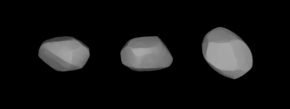
Back 80 Sappho Arabic 80 Sappho (كويكب) ARZ 80 Sappho AST (80) Сапфо Byelorussian (80) Safo Catalan (80) Сапфо CE Sappho (planetka) Czech (80) Sappho German 80 Σαπφώ Greek 80 Sapfo Esperanto
 Lightcurve-based 3D-model of Sappho | |
| Discovery | |
|---|---|
| Discovered by | N. R. Pogson |
| Discovery site | Madras Obs. |
| Discovery date | 2 May 1864 |
| Designations | |
| (80) Sappho | |
| Pronunciation | /ˈsæfoʊ/[1] |
Named after | Sappho (Greek poet) |
| main-belt · (inner) | |
| Adjectives | Sapphonian /sæˈfoʊniən/[2] Sapphoian /sæˈfoʊ.iən/[3] |
| Symbol | |
| Orbital characteristics[4] | |
| Epoch 4 September 2017 (JD 2458000.5) | |
| Uncertainty parameter 0 | |
| Aphelion | 2.7544 AU (412.05 Gm) |
| Perihelion | 1.8370 AU (274.81 Gm) |
| 2.2957 AU (343.43 Gm) | |
| Eccentricity | 0.19980 |
| 3.48 yr (1270.5 d) | |
| 287.260° | |
| 0° 17m 0.06s / day | |
| Inclination | 8.676° |
| 218.699° | |
| 139.662° | |
| Earth MOID | 0.843652 AU (126.2085 Gm) |
| Jupiter MOID | 2.7319 AU (408.69 Gm) |
| TJupiter | 3.553 |
| Physical characteristics[4] | |
| 68.563±1.033 km | |
| Mass | (4.6 ± 2.11/0.86)×1017 kg[5] |
Mean density | 3.055 ± 1.400/0.569 g/cm3[5][a] |
| 14.03087[6] h | |
Pole ecliptic latitude | 194°[6] |
Pole ecliptic longitude | −26°[6] |
| 0.206±0.014[4] 0.185 [7] | |
| S-type asteroid | |
| 9.38 to 13.6 | |
| 7.98 | |
80 Sappho (symbol: ![]() )is a large, S-type (stony) main-belt asteroid. It was discovered by English astronomer Norman Pogson on 2 May 1864, and is named after Sappho, the Archaic Greece poet. The asteroid is orbiting the Sun at a distance of 2.2957 AU with a period of 3.48 years and an eccentricity (ovalness) of 0.2. The orbital plane is inclined at an angle of 8.68° to the plane of the ecliptic.[4]
)is a large, S-type (stony) main-belt asteroid. It was discovered by English astronomer Norman Pogson on 2 May 1864, and is named after Sappho, the Archaic Greece poet. The asteroid is orbiting the Sun at a distance of 2.2957 AU with a period of 3.48 years and an eccentricity (ovalness) of 0.2. The orbital plane is inclined at an angle of 8.68° to the plane of the ecliptic.[4]
13-cm radar observations of this asteroid from the Arecibo Observatory between 1980 and 1985 were used to produce a diameter estimate of 83 kilometres (52 mi).[8] Hanuš et al. (2013) confirmed the polar axis has ecliptic coordinates (λ, β) = (194°, −26°) and listed a rotation period of 14.03087 h.[6]
Sappho (at apparent magnitude 11.8) occulted the magnitude 7.2 star HIP 24403 in the constellation of Taurus on 16 September 2018 at 8:54 UT.[9][10] Sacramento and Salt Lake City were the two major cities located underneath the shadow path. Data from this event will help improve the shape model of the asteroid. During the occultation the asteroid was roughly 1.6 AU (240,000,000 km; 150,000,000 mi) from Earth with an uncertainty of ±76 km.
- ^ "Sappho". Oxford English Dictionary (Online ed.). Oxford University Press. (Subscription or participating institution membership required.)
- ^ Catherine Hobbs (1995) Nineteenth-century Women Learn to Write
- ^ The Thistle, January 1903, vol. I, no. 2, p. 4
- ^ a b c d Cite error: The named reference
JPLwas invoked but never defined (see the help page). - ^ a b Cite error: The named reference
FiengaEtAl2020was invoked but never defined (see the help page). - ^ a b c d Cite error: The named reference
Hanus2013was invoked but never defined (see the help page). - ^ "Asteroid Data Sets". Archived from the original on 17 December 2009. Retrieved 13 January 2007.
- ^ Cite error: The named reference
Ostro1985was invoked but never defined (see the help page). - ^ Cite error: The named reference
HIP24403was invoked but never defined (see the help page). - ^ "(80) Sappho / HIP 24403 event on 2018 Sep 16, 08:54 UT". Archived from the original on 15 September 2017.
Cite error: There are <ref group=lower-alpha> tags or {{efn}} templates on this page, but the references will not show without a {{reflist|group=lower-alpha}} template or {{notelist}} template (see the help page).